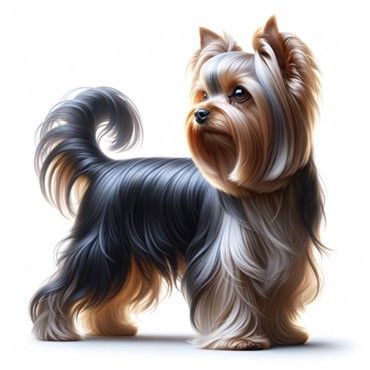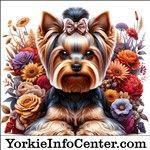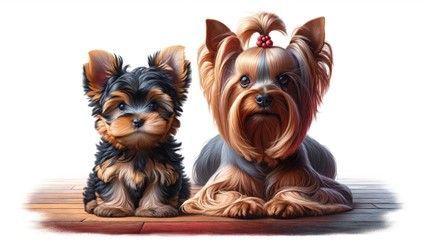What Does a Yorkie Look Like?
Overview
The Yorkshire Terrier is a compact, toy-sized breed known for its distinct appearance and limited color palette.
This section covers size, color overview, changes in appearance as a Yorkie matures, coat type, tail overview, ear overview, pet vs show appearance summary and the breed standard explained.
And if you are looking for more appearance information, see the 'Related Articles' below.
Yorkshire Terrier Size:
Breed Standard Size: The Yorkshire Terrier is classified in the AKC toy group. And the AKC standard for the Yorkshire Terrier calls out for a dog that at full adult size will not exceed 7 lbs. (3.17 kg). This holds true for registries around the world. The standard of the Canadian Kennel Club (CKC) uses the same wording, 'Not to exceed 7 lbs. (3.17 kg)', while both the FCI and KC standards are worded as 'Up to 3.2 kg (7.05 lbs.)'.
Actual Size: Most, but certainly not all, pet Yorkies will fall between 4 and 8 lbs. (1.81 and 3.6 kg). It’s rare for an adult dog to be under 3 lbs. and it’s not uncommon for dogs to be slightly over what is preferred in the show ring.
In our owners survey, in which 2,146 people responded, just looking at the adults (1,867 Yorkies) reported weights were as follows:
More than 8 lb. (3.63 kg) 21%
8 lb. (3.63 kg) 11%
6 lb. (2.72 kg) 9%
4.5 lb. (1.81 kg) 8%
5 lb. (2.26 kg) 8%
4 lb. (1.81 kg) 7%
5.5 lb. (2.49 kg) 7%
6.5 lb. (2.94 kg) 6%
7 lb. (3.17 kg) 6%
7.5 lb. (3.40 kg) 5%
3.5 lb. (1.58 kg) 5%
I'm not sure 3%
3 lb. (1.36 kg) 2%
2.5 lb. (1.13 kg) 2%
Yorkshire Terrier Color:
The 4 official colors of the Yorkie are: Black & Gold (S 234), Black & Tan (S 018), Blue & Gold (S 041) and Blue & Tan (S 044). Note that ‘S’ stands for ‘standard’, as opposed to ‘A’ for an alternate color.
Puppies are black and gold (or tan). As a pup matures, the tan will usually darken into a richer gold. The black is rather prominent and both black and tan can intermingle.
Adults are blue and tan. The blue is a dark steel-blue (not a light grey). Tan is typically seen on the head, chest, and legs, and blue is typically seen on the body and over the tail.
Nose and Eye Color: The nose, along with eye rims, lips, and paw pads are black. Newborns may be born with a pink nose; but, this quickly transitions to black, typically within the first week. Eyes are dark brown.
The reason behind limited colors: The distinctive coloration of Yorkshire Terriers is a direct outcome of selective breeding practices, aimed at adhering to the established standards that have been set since the breed's inception in 19th-century England.
Breeders have deliberately chosen specific traits, including coat color, to ensure the preservation of the breed's iconic appearance. This focus on genetics limits the range of colors in Yorkies, contrasting with other dog breeds that have been bred for various functions, resulting in a wider array of colors. Consequently, the Yorkshire Terrier maintains a restricted color palette, upholding its unique and historically important appearance.

Changes in Appearance as a Yorkie Matures:
Birth to Puppyhood:
Yorkie puppies greet the world with a black and tan coat that is oft and fluffy. This initial coat serves as a warm, cuddly introduction to their early weeks of life. The softness provides a tactile delight, making them irresistible to hold and cuddle. A young pup's body is rounded, as opposed to the leaner, sleeker appearance of adult Yorkies.
The Color Transformation:
By the age of about six months, a Yorkshire Terrier's coat begins its transformation. The black in their coat starts to fade into a steel blue or silver, initiating from the back and gradually encompassing their entire body. This color change can happen very slowly, taking up to three years, and it ends with the iconic adult coat of blue and gold or blue and tan coat. The exact hue of blue varies among individuals, contributing to each Yorkie's unique appearance.
Coat Texture Evolution:
Alongside color changes, the texture of a Yorkie's coat undergoes a transformation as well. The soft puppy coat evolves into a finer, silkier texture, emblematic of adult Yorkshire Terriers. If kept long, this luxurious coat demands regular grooming to stay glossy and tangle-free.
Physical Maturation:
As they mature, Yorkshire Terriers also experience changes in their physique, becoming more refined and elegant. Their body becomes well-proportioned, embodying the breed's standards. However, the transformation of their coat from the puppy stage to adulthood is the most striking change, signifying their development into mature, graceful Yorkshire Terriers.
Yorkshire Terrier Coat Type:
The Yorkshire Terrier has a single coat of hair, not fur. One main difference in hair vs fur is that fur stops growing at a certain length, but hair continues to grow. This is why the Yorkie can grow long show coats seen in conformation events (with some breeds, the hair curls). The majority of pet parents keep their Yorkshire Terrier's coat short via grooming trims, as this prevents hair tangles that are common with long show coats.
There is also a difference in shedding. Hair does fall out, but at a minimal rate, so shedding is much less of an issue that with the many breeds that have thick fur coats.
And while the Yorkshire Terrier is one of several breeds that has been deemed ‘hypoallergenic’, this can be misleading, as many dog allergies are to a dog's dander (dead flakes of skin) and/or proteins found in a dog’s saliva and urine
Yorkshire Terrier Tails:
In some countries, Yorkshire Terriers competing in conformation show rings are expected to have their tails docked. The AKC specifies that the tail should be 'Docked to a medium length and carried slightly higher than the level of the back.' Meanwhile, other countries prohibit dogs with docked tails from entering conformation events, although some clubs may allow either option.
With this in mind, in 2017 we conducted a poll asking, 'If you have a Yorkie, is the tail docked?' There were 2,172 pet parents that responded. The results were:
- 67.91% (1,475 owners) answered 'yes,'
- 32.09% (697 owners) answered 'no.'
When looking at responses filtered by country, among respondents in the US, 71.23% (1,265 owners) answered 'yes,' and 28.77% (511 owners) answered 'no.' In Canada, 59.2% (74 owners) responded 'yes,' and 40.8% (51 owners) responded 'no.' For respondents in the United Kingdom, 20.51% (8 owners) answered 'yes,' while 79.49% (31 owners) answered 'no.'
Read more about Yorkshire Terrier Tail Docking or continue on for more appearance facts.

Yorkshire Terrier Ears:
Yorkshire Terriers have small, V-shaped [like a triangle] ears that are carried erect and set not too far apart. Puppies are born with floppy ears and they will gradually stand up, usually between the age of 3 months and 6 months old. Some pups are late bloomers and in rare cases (usually if there is a mix somewhere in the bloodline), one or both ears will be folded or not stand up at all.
In the same poll as referenced above under "Tails', we asked pet parents of Yorkshire Terriers, "Which describes your Yorkie's ears?", and answers were as follows:
- Both standing erect 71%
- Floppy 13%
- A bit floppy 7%
- Standing, but one/both can drop once in a while 6%
- Other 3%
Pet vs Show Appearance:
The Breed Standard Explained:
To establish an official dog breed, a standard must define its characteristics, such as size, coat, facial and body structure, and temperament. The AKC, along with other organizations like the CKC, KC, and FCI, adhere to breed standards set by the breed's parent club, ensuring consistency across various countries.
Breed standards serve two main purposes: guiding breeders in producing dogs that adhere to the standard and aiding judges in evaluating dogs in conformation events. These standards are periodically reviewed, typically every five years, but revisions are often minimal. As of 2017, the AKC's Yorkshire Terrier standard hasn't changed since 2007.
The following is the AKC breed standard, along with our explanations in brackets and alternative color.
General Appearance - That of a long-haired toy terrier whose blue and tan coat is parted on the face and from the base of the skull to the end of the tail and hangs evenly and quite straight down each side of body. The body is neat, compact [this means “closely and neatly packed together” and by using this word, it is meant to describe how the Yorkshire Terrier’s extremities are all close to the body… legs are not overly long, ears are small, tail is held close to the body], and well-proportioned [no certain parts of the body overwhelms the other, for example, no large ears, long legs, or long snout].
The dog’s high head carriage [the way in which the head is held high and proud] and confident manner should give the appearance of vigor [walks as if he has energy] and self-importance [sense of pride].
Head - Small and rather flat on top, the skull not too prominent or round, the muzzle not too long, with the bite neither undershot [lower jaw is longer than the upper jaw] nor overshot [upper jaw is longer than the lower jaw] and teeth sound [no chipping, straight and strong].
Either scissors bite or level bite is acceptable [a scissor bite is when the incisor teeth in the upper jaw are in contact with but slightly overlap those in bottom jaw. This creates a scissor appearance due to the pre-molars and molars meeting down the side of the mouth. A level bite is one where the incisor teeth meet exactly, surface to surface].
The nose is black.
Eyes
are medium in size and not too prominent
[do not bulge out when looking at the dog from the side]
dark in color and sparkling with a sharp, intelligent expression
[the dog looks alert and aware].
Eye rims
are dark.
Ears
are small, V-shaped
[like a triangle], carried erect and set not too far apart.
Teddy Bear Yorkies - What this terms means and the various ways that it can be used to explain either a close 'puppy cut' hair style or, in some cases, a Yorkshire Terrier mixed breed.
Yorkshire Terrier Size - How this breed compares to other popular toy breeds including the Pomeranian, Chihuahua and Shih Tzu. And what to expect in terms of how large your Yorkie will grow to be.
Teacup Yorkshire Terriers - This terms seems redundant as the Yorkie is one of the smallest breeds in the world; this is mainly seen with marketing to imply the dog is smaller than average (nearly impossible for this breed).


